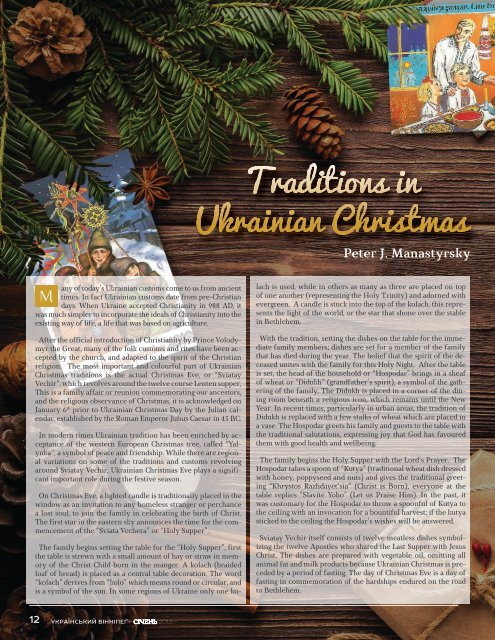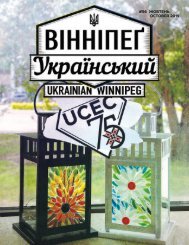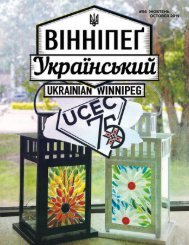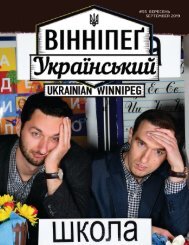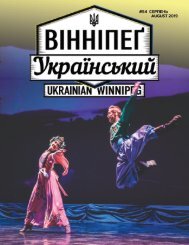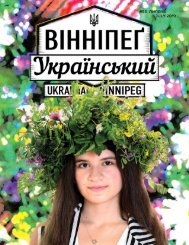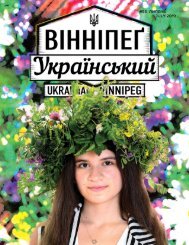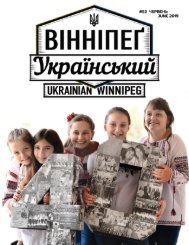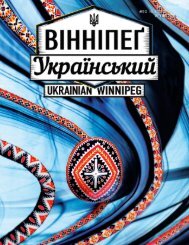Create successful ePaper yourself
Turn your PDF publications into a flip-book with our unique Google optimized e-Paper software.
Peter J. Manastyrsky<br />
M<br />
any of today’s Ukrainian customs come to us from ancient<br />
times. In fact Ukrainian customs date from pre-Christian<br />
days. When Ukraine accepted Christianity in 988 AD, it<br />
was much simpler to incorporate the ideals of Christianity into the<br />
existing way of life, a life that was based on agriculture.<br />
After the official introduction of Christianity by Prince Volodymyr<br />
the Great, many of the folk customs and rites have been accepted<br />
by the church, and adapted to the spirit of the Christian<br />
religion. The most important and colourful part of Ukrainian<br />
Christmas traditions is the actual Christmas Eve, or “Sviatay<br />
Vechir”, which revolves around the twelve course Lenten supper,<br />
This is a family affair or reunion commemorating our ancestors,<br />
and the religious observance of Christmas, it is acknowledged on<br />
<strong>January</strong> 6 th prior to Ukrainian Christmas Day by the Julian calendar,<br />
established by the Roman Emperor Julius Caesar in 45 BC.<br />
In modern times Ukrainian tradition has been enriched by acceptance<br />
of the western European Christmas tree, called “Yalynka”,<br />
a symbol of peace and friendship. While there are regional<br />
variations on some of the traditions and customs revolving<br />
around Sviatay Vechir, Ukrainian Christmas Eve plays a significant<br />
important role during the festive season.<br />
On Christmas Eve, a lighted candle is traditionally placed in the<br />
window as an invitation to any homeless stranger or perchance<br />
a lost soul, to join the family in celebrating the birth of Christ.<br />
The first star in the eastern sky announces the time for the commencement<br />
of the “Sviata Vechera” or “Holy Supper”.<br />
The family begins setting the table for the “Holy Supper”, first<br />
the table is strewn with a small amount of hay or straw in memory<br />
of the Christ Child born in the manger. A kolach (braided<br />
loaf of bread) is placed as a central table decoration. The word<br />
“kolach” derives from “kolo” which means round or circular, and<br />
is a symbol of the sun. In some regions of Ukraine only one ko-<br />
lach is used, while in others as many as three are placed on top<br />
of one another (representing the Holy Trinity) and adorned with<br />
evergreen. A candle is stuck into the top of the kolach, this represents<br />
the light of the world, or the star that shone over the stable<br />
in Bethlehem.<br />
With the tradition, setting the dishes on the table for the immediate<br />
family members; dishes are set for a member of the family<br />
that has died during the year. The belief that the spirit of the deceased<br />
unites with the family for this Holy Night. After the table<br />
is set, the head of the household or “Hospodar” brings in a sheaf<br />
of wheat or “Didukh” (grandfather’s spirit), a symbol of the gathering<br />
of the family. The Didukh is placed in a corner of the dining<br />
room beneath a religious icon, which remains until the New<br />
Year. In recent times, particularly in urban areas, the tradition of<br />
Didukh is replaced with a few stalks of wheat which are placed in<br />
a vase. The Hospodar greets his family and guests to the table with<br />
the traditional salutations, expressing joy that God has favoured<br />
them with good health and wellbeing.<br />
The family begins the Holy Supper with the Lord’s Prayer. The<br />
Hospodar takes a spoon of “Kutya” (traditional wheat dish dressed<br />
with honey, poppyseed and nuts) and gives the traditional greeting<br />
“Khrystos Razhdayet’sia” (Christ is Born), everyone at the<br />
table replies “Slavite Yoho” (Let us Praise Him). In the past, it<br />
was customary for the Hospodar to throw a spoonful of Kutya to<br />
the ceiling with an invocation for a bountiful harvest; if the kutya<br />
sticked to the ceiling the Hospodar’s wishes will be answered.<br />
Sviatay Vechir itself consists of twelve meatless dishes symbolizing<br />
the twelve Apostles who shared the Last Supper with Jesus<br />
Christ. The dishes are prepared with vegetable oil, omitting all<br />
animal fat and milk products because Ukrainian Christmas is preceded<br />
by a period of fasting. The day of Christmas Eve is a day of<br />
fasting in commemoration of the hardships endured on the road<br />
to Bethlehem.<br />
12 <strong>Український</strong> <strong>Вінніпеґ</strong> - СІЧЕНЬ <strong>2018</strong> -


